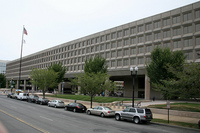Where should the Latino museum go?
Congress has declared the National Mall a “completed work of civic art” and declared that future museums and memorials should go on sites outside the Mall, but that hasn’t stopped them from making exception after exception. Now, the planned National Museum of the American Latino wants to be on the Mall, too, and looks likely to get it.
After all, the National Museum of the American Indian is on the Mall (before the moratorium was enacted), and the National Museum of African-American Art and Culture got to be on the Mall even after the moratorium. Therefore, Latino groups ruled out all non-Mall sites originally proposed, reports the National Coalition to Save Our Mall, leaving four:

Image from NCPC.
Some of the Mall sites under consideration wouldn’t require building new structures in open space, or would at least reuse parts of existing structures. One (green oval, above) would be to use the currently-vacant yet beautiful Arts and Industries Building. However, it’s too small and can’t facilitate exhibits, so the suggestion is to also replace part of the Forrestal Building across Independence Avenue and connect the two with a tunnel.
I consider the Forrestal Building to be the ugliest building in DC, and hopefully one modern structure preservationists won’t try to keep. NCPC’s long-term plan calls for redeveloping the site as well. However, the GSA representative told NCPC they aren’t ready to redevelop it right now, making that site potentially infeasible.
Another option would be to use the Whitten Building (blue oval), which currenly houses the Department of Agriculture. The museum would add two stories atop on of the building’s wings and build a structure in an adjacent surface parking lot. Filling in a parking lot is appealing, but the Coalition wonders if altering one wing of this “symmetrical, beaux-arts building” would pass historic muster.
The other two options involve building in what is currently open space. One site (purple oval, above) is adjacent to the Capitol between Pennsylvania, Constitution, and 1st NW, the site directly opposite the Botanic Garden. DCmud notes that this was originally envisioned to house a museum by the McMillan Plan. However, the Architect of the Capitol controls this land, and rejected it for the African-American museum.
Finally, there’s the land between 14th and 15th, SW along Independence, opposite the site for the African-American museum. A new building would be built here, and offices would go in the historic Yates Building across Independence. The Coalition sees that as the most likely but also very undesirable, because it’s considered part of the Washington Monument grounds. However, NPS didn’t object to this site at the NCPC meeting.
What do you think of these sites? The Coalition also notes that NCPC only held an “informational” presentation, which afforded no opportunity for public comment, and urged NCPC to engage in a public discussion about this issue.
While Mall proliferation is a real problem, now that the American Indians and African-Americans are getting a museum, it seems not unreasonable for Latinos to get one as well, as one of the US’s largest minority groups. But it’s important to resist further proliferation, because there is an endless list of other groups as well.
As DCmud jokingly notes, “Fear not, Lithuanians and Samoans, you too may someday have your chance.” That would be disastrous. It’s also perhaps somewhat unlikely, but what about non-ethnic minorities? Should there be a women’s museum and a museum about elderly people and one for persons with disabilities?
The Vietnam Veterans Memorial Visitors center was more troubling because it opened the door to visitors’ centers for veterans of every war. I’m less disturbed by more cultural museums on the Mall than memorials or memorial visitors’ centers. There are always going to be more wars and more great leaders, and unless we start retiring memorials as Philip Kennicott suggested, they threaten to clutter the Mall up without pause for every historic event or figure that has a number of dedicated adherents.

